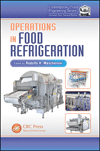Product Details
Features
- Describes the physical basis of heat and mass transfer in refrigeration operations
- Provides tools for the calculation of process times and selection of industrial equipment and operation conditions
- Describes all the operations involved in pretreatments during the preparation of foods for refrigeration and freezing
- Presents the principles involved in emerging novel refrigeration and freezing processes such as dehydrofreezing, hydrofluidization, and ultrasonic freezing
- Covers all major food types, including fruits, vegetables, juices, meats, and seafood
Summary
The final quality of a food product is impacted heavily by preservation technologies, such as chilling, freezing, and freeze-drying, as well as the numerous pretreatments that are routinely applied to foods. Adequate design and implementation of each of these treatments are critical to ensuring the integrity of the final food product, the productivity of the equipment, and reduced operation costs. Operations in Food Refrigeration explores the fundamental issues involved in heat and mass transfer in food refrigeration and examines aspects of other operations applied to chilled or frozen foods.
Following an overview of basic concepts and general calculation procedures involved in cooling, freezing, thawing, and freeze-drying, the book discusses:
- Sizing, peeling, cutting, sorting, and blanching fruits and vegetables
- Pretreatments for meats, including tenderization, electrical stimulation, portioning, curing, and smoking
- Pretreatments for fish and other seafood
- Processing of poultry
- Air and osmotic partial dehydration, infusion of special nutrients, and the concentration of juices
- Traditional chilling and freezing methods
- Special precooling and freezing techniques
- The effects of thawing on food, factors that influence the choice and design of thawing processes, and various thawing methods
- Freeze-drying equipment
Each chapter is written by a recognized specialist and can serve as a stand-alone resource for the particular topic. Several chapters present case studies that can be used for developing processes or in teaching applications. Processors, researchers, and educators in the food industry will find this volume to be an invaluable reference for a host of food operations.
